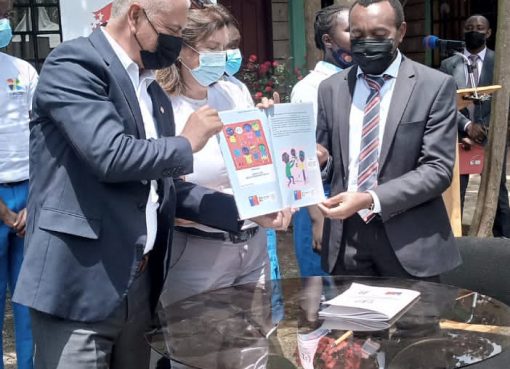Maurine Atieno (not her real name) is a 15-year-old girl in Migori’s Apida estate. Every morning at 5am she trudges out to a nearby river to fetch water for her masters’ household. She also helps prepare and serve the family’s meals, runs errands, sweeps the yard, washes dishes and clothes every day. Atieno has no shoes except quarter-heel-chopped-off red sandals, which she always uses to protect her already cracked feet.
The girl, an orphan, lost her parents through a road accident three years ago, when she was only 12 years old. After her parents’ burial, she was taken in by one of her uncles who lived in Nairobi. She would later flee from the family citing mistreatment by her guardians.
Atieno claims she slept on thin-torn mattress with insufficient beddings and frequently received beatings from her aunt on the slightest provocation besides being fed on left overs.
She says life became unbearable forcing her to flee from the people she first trusted with her life. “I was made a slave in a house I thought was I would get happiness and solace after the death of my parents,” she told KNA recently.
With no one to turn to, she decided to return to Migori to look for a job to enable her sustain herself. The job-hunt ended when a Good Samaritan picked her late one Sunday evening as she was wondered about in Migori town streets after getting a lift in a bus from the City.
The Good Samaritan found her a job as a house help earning a paltry Sh400 per month despite the hard work and alleged mistreatment in her masters’ house. The teenager, who has never been to school, now yearns to study at least up to secondary school, as she believes it would change her life.
Atieno’s heart-rending story is the untold anecdotes of child labour worldwide, a vice many nations, including Kenya, are fighting hard to eliminate at all costs. And behind the many mansion walls we see in towns and markets, Migori included, are sad stories of child labour practices safely protected from the world’s eyes.
Child labour, broadly defined as the employment of children often in harsh conditions and for minimal pay, remains rife in the developing and developed countries alike. The human cost of child labour is immense, it leaves children gaunt and crippled, sick and uneducated.
The International Labour Organisation (ILO), perhaps is the most important world’s efforts to eliminate child labour globally. The organisation has introduced several child labour conventions among its members including a minimum age limit of 16 for employment, a higher minimum age requirement for specific jobs and compulsory medical examinations as well as regulations on night work.
In the late 20th century, ILO added slavery, prostitution, debt bondage (the practice of requiring children to work to clear loans to their parents), and forced military services to its list of the worst forms of child labour.
A growing concern in recent years has been the increase in prostitution among youths in urban centres. Adverse poverty dogging most families has been blamed as the trigger behind many children turning to prostitution.
A 1997 United Nations Children’s Fund (UNICEF) report on child labour says unscrupulous employers will always be tempted to hire children, as they are easier to exploit. “The most vulnerable and weakest workers, children, can usually be paid less than adults and are considerably less likely than adults to know their rights or to protest working conditions,” says the report.
Poverty, it adds, plays and enormous role in the phenomenon of child labour. Desperate for money, poor families around the world, including Kenya, are forced to push even young children to work to increase the family’s overall income.
For poor families, the small contribution of a child’s income or assistance can make the difference between hunger and a bare sufficiency, the survey further states.
In Kenya, a stroll in the streets of Migori town at night will leave anyone shocked upon realising the age of female youths reveling in most nightclubs and disco halls as prostitutes.
Migori County Director of Children Services John Odinya says most of the girls have adopted the practice to earn cash to cater for their poor parents back at home.
“Because they do not want their parents and siblings to suffer due to lack of funds, the young girls agree to let their bodies be used by men for as little as sh.50 in total disregard of the risks of contracting the deadly virus HIV/AIDS,” says Odinya.
Statistics at the local labour office indicate over 20,000 underage girls in the county have been lured or forced into commercial sexual exploitation by wealthy men in search of sexual satisfaction. Adding to the tragedy, if these child prostitutes ever escaped and find their way home, they are often stigmatised and rejected by their families and communities, says the official.
Apart from prostitution, a high percentage of underage children are engaged in maize harvesting, cattle herding, charcoal burning, brick-making and as housemaids. Many of the youth get into such jobs after dropping out of school either willingly or as a result of exorbitant school levies imposed on parents by learning institutions.
A survey by the local education office in 2017 indicates that children drop out of school because the institutions are so rigid and classes so uninspiring that they (pupils) prefer to prematurely end their education at an early age to look for paying jobs.
The survey also cites that tradition contributes to the high rate of child labour. Tradition plays an important role in exacerbating the issue in the county, as girls as young as 7-years, have long worked as domestic servants.
Children Services boss says his office registers up to 200 cases of child abuse monthly, most of them perpetuated by parents and employers. But he is concerned most of the cases are never pursued to the end since the police, labour office and courts drop them prematurely.
“Our efforts to fight the vice in this region has been sabotaged by our own law enforcers who opts to free suspects before taking them to court,” lamented Odinya when we sought his comment on the status of child labour in the area recently.
Despite the shortage of labour inspectors, the few available have failed to enforce regulations to curb the vice. Some cases involving child labour have been ignored after rich employers compromised labour officers.
Often, inspectors tip off employers before the inspections of workplaces begins and even when not alerted, the officers do not get any evidence as the children flee the facilities as soon as the team arrives,
Odinya says the region is known for serious child labour problems. Over 50 percent of underage teenagers have been forced to leave their studies to take up tasks of herding cattle, Cases of children as young as 11 years working for over 12 hours a day in maize fields and toiling in hot, acrid brick-making factories spread throughout the county are common in the area.
“Despite earning meagre income, the children are always determined to endure the worst kind of mistreatment they often undergo in the hands of their masters,” adds the children’s boss.
“They work for long hours under bad conditions and are paid peanuts by the highly exploiting employers,” said Odinya.
According to child labour conventions set by ILO, the minimum working age and time for specific jobs are well spelt out by the labour body.
Such laws, however vary vastly between countries. Often there are different minimum ages for varying types of work.
For instance, in Egypt, the legal minimum for all work is 12 years while in Philippines is 14. In Peru, the minimum age limit in agriculture is 14 and in industry is 15. Those in deep sea fishing have to have 16 years as the minimum age.
On the same note, India has prohibited children below age 14 from making rugs or explosives. In Germany, the minimum age for light industrial work is 13, and in Italy the threshold age for working with machines is 15.
Unfortunately, in Kenya, children of whatever age work in all sectors for long hours. It is, therefore, a challenge to the Government and both the local and international organisations involved in fight against child labour to ensure that laws are strictly adhered to if the lives of the youngsters are to be protected well.
By George Agimba




